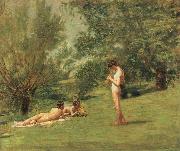Wholesale Oil Painting No Minimum |
|||||||||||
|
|
|||||||||||

|
|||||||||||
|
|
|
||||||||
Thomas EakinsAmerican Realist Painter, 1844-1916. Thomas Cowperthwait Eakins (July 25, 1844 ?C June 25, 1916) was a realist painter, photographer, sculptor, and fine arts educator. He is widely acknowledged to be one of the most important artists in American art history. For the length of his professional career, from the early 1870s until his health began to fail some forty years later, Eakins worked exactingly from life, choosing as his subject the people of his hometown of Philadelphia. He painted several hundred portraits, usually of friends, family members, or prominent people in the arts, sciences, medicine, and clergy. Taken en masse, the portraits offer an overview of the intellectual life of Philadelphia in the late 19th and early 20th centuries; individually, they are incisive depictions of thinking persons. As well, Eakins produced a number of large paintings which brought the portrait out of the drawing room and into the offices, streets, parks, rivers, arenas, and surgical amphitheaters of his city. These active outdoor venues allowed him to paint the subject which most inspired him: the nude or lightly clad figure in motion. In the process he could model the forms of the body in full sunlight, and create images of deep space utilizing his studies in perspective. No less important in Eakins' life was his work as a teacher. As an instructor he was a highly influential presence in American art. The difficulties which beset him as an artist seeking to paint the portrait and figure realistically were paralleled and even amplified in his career as an educator, where behavioral and sexual scandals truncated his success and damaged his reputation. Eakins also took a keen interest in the new technologies of motion photography, a field in which he is now seen as an innovator. Eakins was a controversial figure whose work received little by way of official recognition during his lifetime. Since his death, he has been celebrated by American art historians as "the strongest, most profound realist in nineteenth-and early-twentieth-century American art". |
||||||||
|
|
||||||||
Arcadia
Arcadia Painting ID:: 38737 |
mk141
ca.1883
Oil on canvas
98.1x114.3cm
The Metropolitan Museum of Art.
New York
mk141 ca.1883 Oil on canvas 98.1x114.3cm The Metropolitan Museum of Art. New York |
|||||||
|
|
||||||||
Charles conderEnglish-born Australian Painter, 1868-1909 English painter, active in Australia and France. He was sent to Australia in 1884 to learn surveying under his uncle W. J. Conder. After about two years in survey camps, he attended evening classes at the Royal Art Society, Sydney; in 1887 he worked as a lithographic draughtsman for the Illustrated Sydney News. Tom Roberts, then in Sydney on a visit from Melbourne, was among the open-air landscape painters that he knew at this time. He taught Conder some of the principles of Impressionism, such as truth to the momentary effect of light and to colour values, and the rejection of the academic ideal of high finish. The most important painting of Conder's Sydney years, the Departure of the 'SS Orient' from Circular Quay, 1888 (1888; Sydney, A.G. NSW), already showed a distinct personal style, combining humour with nostalgia and selective observation with decorative finesse of handling and design. In December 1888 Conder joined Roberts and Arthur Streeton in Melbourne. During the following summers they painted together at the outer suburbs of Mentone, Box Hill and Eaglemont |
||||||||
|
|
||||||||
|
|
Arcadia
Arcadia Painting ID:: 77246 |
1889, oil on cardboard, 11.5 x 24.0 cm) by Charles Conder (1868?C1909).
cyf 1889, oil on cardboard, 11.5 x 24.0 cm) by Charles Conder (1868?C1909). cyf |
||||||
|
|
||||||||
|
Charles conder English-born Australian Painter, 1868-1909 English painter, active in Australia and France. He was sent to Australia in 1884 to learn surveying under his uncle W. J. Conder. After about two years in survey camps, he attended evening classes at the Royal Art Society, Sydney; in 1887 he worked as a lithographic draughtsman for the Illustrated Sydney News. Tom Roberts, then in Sydney on a visit from Melbourne, was among the open-air landscape painters that he knew at this time. He taught Conder some of the principles of Impressionism, such as truth to the momentary effect of light and to colour values, and the rejection of the academic ideal of high finish. The most important painting of Conder's Sydney years, the Departure of the 'SS Orient' from Circular Quay, 1888 (1888; Sydney, A.G. NSW), already showed a distinct personal style, combining humour with nostalgia and selective observation with decorative finesse of handling and design. In December 1888 Conder joined Roberts and Arthur Streeton in Melbourne. During the following summers they painted together at the outer suburbs of Mentone, Box Hill and Eaglemont Arcadia 1889, oil on cardboard, 11.5 x 24.0 cm) by Charles Conder (1868?C1909). cyf |
||||||||
|
|
||||||||
|
Prev Next
|
||||||||
|
|
||||||||
|
Related Paintings to Charles conder :. |
||||||||
|
|
||||||||
|
CONTACT US |


